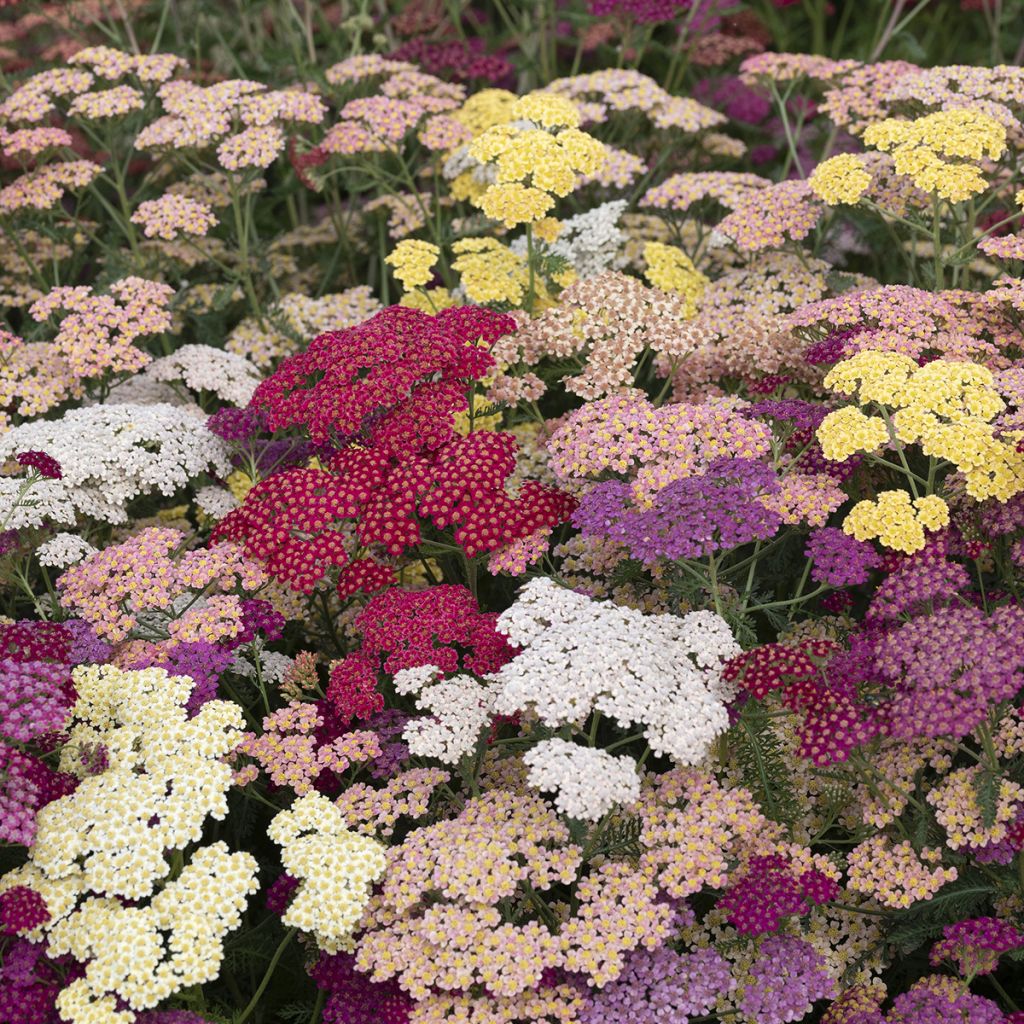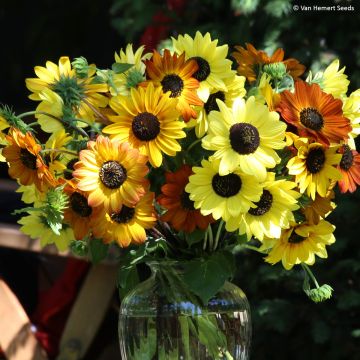

Achillea millefolium Flowerburst Fruitbowl - Yarrow


Achillea millefolium Flowerburst Fruitbowl - Yarrow
Achillea millefolium Flowerburst Fruitbowl - Yarrow
Achillea (x) millefolium Flowerburst Fruitbowl
Common Yarrow
Special offer!
Receive a €20 voucher for any order over €90 (excluding delivery costs, credit notes, and plastic-free options)!
1- Add your favorite plants to your cart.
2- Once you have reached €90, confirm your order (you can even choose the delivery date!).
3- As soon as your order is shipped, you will receive an email containing your voucher code, valid for 3 months (90 days).
Your voucher is unique and can only be used once, for any order with a minimum value of €20, excluding delivery costs.
Can be combined with other current offers, non-divisible and non-refundable.
Home or relay delivery (depending on size and destination)
Schedule delivery date,
and select date in basket
This plant carries a 6 months recovery warranty
More information
We guarantee the quality of our plants for a full growing cycle, and will replace at our expense any plant that fails to recover under normal climatic and planting conditions.
Would this plant suit my garden?
Set up your Plantfit profile →
Description
Achillea millefolium 'Flowerburst Fruitbowl' consists of a mixture of various yarrow seeds, intended to produce a multi-coloured flowering. It allows for easy landscaping of a slope or flowering of a plant bed throughout the summer. Extremely floriferous and easy to cultivate in most soils, these perennials are unmatched in brightening up a bed or border. They also allow for the creation of generous bouquets, fresh or dried, to extend the pleasure indoors.
Yarrow is part of the vast Asteraceae family (formerly Compositae), which, with its 23,500 species, is the second largest in the plant kingdom, just after Orchids. The genus Achillea itself includes dozens of species, the most well-known being Yarrow, which is widespread throughout the northern hemisphere. This plant has been part of traditional pharmacopoeia for over three millennia. Its scientific name comes from the Greek hero Achilles, who is said to have used it to heal his own wounds as well as those of his soldiers during the Trojan War, more than a thousand years before Christ. It is also commonly known as soldier's herb (among many other names). In nature, this plant is mainly found on roadsides or in sparsely wooded areas, as it thrives in full sun and does not like shade. It is a long-lived perennial plant that spreads through underground rhizomes and can occasionally become undesirable in cultivated areas.
There are multiple horticultural varieties, prized for their ease of cultivation and their ability to provide ground cover. This 'Flowerburst Fruitbowl' selection produces branched plants, standing 70 to 75 cm (28 to 30in) tall and just as wide. They have fairly ornamental, deciduous to semi-evergreen foliage, consisting of elongated and narrow leaves, usually measuring 5 to 10 cm (2 to 4in) long and 1 to 3 cm (0.5 to 1in) wide. With a matte dark green colour, the leaf blades are doubly divided (bipinnately lobed), giving them a graceful appearance reminiscent of small ferns. The foliage has a slightly aromatic scent when crushed, releasing a faint camphor odor.
Flowering begins around the end of June and continues until September. In classic Asteraceae fashion, the inflorescences are corymbs in the shape of more or less flattened domes, composed of a profusion of small flowers that are actually heads. They combine tubular florets at the central disk, while the peripheral florets are ligulate. These inflorescences measure 5 to 10 cm (2 to 4in) in diameter and form an imposing mass on the delicate vegetation. For a spectacular visual effect, this 'Flowerburst Fruitbowl' mix combines yellow, pink, apricot, raspberry red, and cream white flowers.
Beautiful in the garden, these colorful clumps will also provide stunning fresh bouquets to decorate the house. The floral stems can even be included in dried bouquets with other suitable plants, such as the lovely Love-in-a-mist.
Easy to cultivate in all types of soil, drought-tolerant, Yarrow 'Flowerburst Fruitbowl' will fit perfectly in varied beds that it will enliven with its colors. Its root system will also help stabilize a slope, protecting it from erosion. It can also be used as a groundcover in non-trafficked areas as a substitute for grass. Planted alongside other flowering perennials, it will create a dazzling scene in the garden. Consider the Evening Primrose or Oenothera, another sun-loving perennial that produces abundant blooms in summer, with many varieties featuring bright yellow flowers, but also pink or orange. To extend the flowering period of your scene, opt for the Red Giant Allium, a spectacular ornamental garlic that in May-June offers highly graphic blooms in large reddish-purple balls, followed by decorative seed capsules. And to perfect the edge of your bed, nothing beats a carpet of carnations like the Maiden Pink, which will quickly cover the ground and offer vivid pink blooms from June to September.
Report an error about the product description
Flowering
Foliage
Plant habit
Botanical data
Achillea
(x) millefolium
Flowerburst Fruitbowl
Asteraceae
Common Yarrow
Cultivar or hybrid
Other Achillea seeds
View all →Planting and care
Sow Achillea millefolium seeds from February to May, or from September to October, on the surface of a good compost and cover the seeds with a thin layer of vermiculite. Place in a mini-greenhouse at a temperature of 15-24°C (59-75.2°F) or enclose the seed tray inside a polyethylene bag until germination, which usually takes 2 to 4 weeks. Keep in light as this facilitates germination.
When the seedlings are large enough to handle, transplant them into 8 cm (3in) pots and grow them in cooler conditions. When the plants are well developed and all risk of frost has passed, gradually acclimatize the plants to outdoor conditions for 10 to 15 days before planting them outside. Transplant the plants at a distance of 60 to 70 cm (24 to 28in) in well-drained soil in full sun. September sowings will overwinter under a cold frame before being planted outside the following spring.
Plant Achillea millefolium in any soil, even chalky, dry or moist, but well-drained. It even adapts to clay soils if they are healthy and well amended. It will eventually tolerate partial shade, although it much prefers full sun. In cooler climates, planting can be done year-round. In regions with hot, dry summers, it is best to plant in September-October so that the plant can establish well during autumn and winter, to withstand the following summer in good conditions. It is advisable to cut back all the vegetation at the end of the season to promote the growth of new shoots in spring.
Sowing period
Intended location
This item has not been reviewed yet - be the first to leave a review about it.
Similar products
Haven't found what you were looking for?
Hardiness is the lowest winter temperature a plant can endure without suffering serious damage or even dying. However, hardiness is affected by location (a sheltered area, such as a patio), protection (winter cover) and soil type (hardiness is improved by well-drained soil).

Photo Sharing Terms & Conditions
In order to encourage gardeners to interact and share their experiences, Promesse de fleurs offers various media enabling content to be uploaded onto its Site - in particular via the ‘Photo sharing’ module.
The User agrees to refrain from:
- Posting any content that is illegal, prejudicial, insulting, racist, inciteful to hatred, revisionist, contrary to public decency, that infringes on privacy or on the privacy rights of third parties, in particular the publicity rights of persons and goods, intellectual property rights, or the right to privacy.
- Submitting content on behalf of a third party;
- Impersonate the identity of a third party and/or publish any personal information about a third party;
In general, the User undertakes to refrain from any unethical behaviour.
All Content (in particular text, comments, files, images, photos, videos, creative works, etc.), which may be subject to property or intellectual property rights, image or other private rights, shall remain the property of the User, subject to the limited rights granted by the terms of the licence granted by Promesse de fleurs as stated below. Users are at liberty to publish or not to publish such Content on the Site, notably via the ‘Photo Sharing’ facility, and accept that this Content shall be made public and freely accessible, notably on the Internet.
Users further acknowledge, undertake to have ,and guarantee that they hold all necessary rights and permissions to publish such material on the Site, in particular with regard to the legislation in force pertaining to any privacy, property, intellectual property, image, or contractual rights, or rights of any other nature. By publishing such Content on the Site, Users acknowledge accepting full liability as publishers of the Content within the meaning of the law, and grant Promesse de fleurs, free of charge, an inclusive, worldwide licence for the said Content for the entire duration of its publication, including all reproduction, representation, up/downloading, displaying, performing, transmission, and storage rights.
Users also grant permission for their name to be linked to the Content and accept that this link may not always be made available.
By engaging in posting material, Users consent to their Content becoming automatically accessible on the Internet, in particular on other sites and/or blogs and/or web pages of the Promesse de fleurs site, including in particular social pages and the Promesse de fleurs catalogue.
Users may secure the removal of entrusted content free of charge by issuing a simple request via our contact form.
The flowering period indicated on our website applies to countries and regions located in USDA zone 8 (France, the United Kingdom, Ireland, the Netherlands, etc.)
It will vary according to where you live:
- In zones 9 to 10 (Italy, Spain, Greece, etc.), flowering will occur about 2 to 4 weeks earlier.
- In zones 6 to 7 (Germany, Poland, Slovenia, and lower mountainous regions), flowering will be delayed by 2 to 3 weeks.
- In zone 5 (Central Europe, Scandinavia), blooming will be delayed by 3 to 5 weeks.
In temperate climates, pruning of spring-flowering shrubs (forsythia, spireas, etc.) should be done just after flowering.
Pruning of summer-flowering shrubs (Indian Lilac, Perovskia, etc.) can be done in winter or spring.
In cold regions as well as with frost-sensitive plants, avoid pruning too early when severe frosts may still occur.
The planting period indicated on our website applies to countries and regions located in USDA zone 8 (France, United Kingdom, Ireland, Netherlands).
It will vary according to where you live:
- In Mediterranean zones (Marseille, Madrid, Milan, etc.), autumn and winter are the best planting periods.
- In continental zones (Strasbourg, Munich, Vienna, etc.), delay planting by 2 to 3 weeks in spring and bring it forward by 2 to 4 weeks in autumn.
- In mountainous regions (the Alps, Pyrenees, Carpathians, etc.), it is best to plant in late spring (May-June) or late summer (August-September).
The harvesting period indicated on our website applies to countries and regions in USDA zone 8 (France, England, Ireland, the Netherlands).
In colder areas (Scandinavia, Poland, Austria...) fruit and vegetable harvests are likely to be delayed by 3-4 weeks.
In warmer areas (Italy, Spain, Greece, etc.), harvesting will probably take place earlier, depending on weather conditions.
The sowing periods indicated on our website apply to countries and regions within USDA Zone 8 (France, UK, Ireland, Netherlands).
In colder areas (Scandinavia, Poland, Austria...), delay any outdoor sowing by 3-4 weeks, or sow under glass.
In warmer climes (Italy, Spain, Greece, etc.), bring outdoor sowing forward by a few weeks.













































